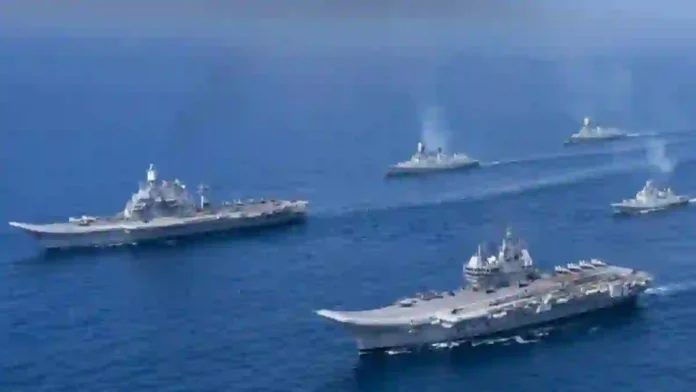India’s naval strength significantly surpasses that of Pakistan in virtually every dimension—fleet size, technological depth, operational doctrine, and indigenous capability. India currently fields a fleet of around 290 vessels, featuring two operational aircraft carriers (INS Vikrant and INS Vikramaditya), 11 destroyers, 12 frigates, 18 corvettes, and 18 submarines, including nuclear-powered platforms.
In stark contrast, Pakistan’s fleet includes 148 ships, with no aircraft carriers or destroyers, 15 frigates, 16 corvettes, and 16 submarines, the majority being older-generation diesel-electric models.
The doctrines guiding these fleets also reflect divergent ambitions and strategic priorities. India follows a blue-water strategy—focused on projecting naval power across the Indo-Pacific, safeguarding sea lanes, and providing credible deterrence against regional threats.
The presence of aircraft carriers enables integrated air-sea operations, extending the operational reach of India’s navy through MiG-29K fighters and multiple helicopter squadrons. Pakistan’s naval doctrine, on the other hand, remains primarily defensive and coastal. Lacking carrier aviation, it relies instead on land-based aircraft with limited operational endurance, focusing mainly on protecting its maritime trade corridors and coastline.
India’s warships are generally more advanced and heavily armed. Kolkata-class destroyers, for example, are equipped with BrahMos supersonic cruise missiles and Barak-8 air defense systems, providing superior long-range strike and multi-layered defense. By contrast, Pakistan’s most modern surface combatants—Tughril-class frigates—feature fewer vertical launch cells and less sophisticated sensor and radar technology, making them less capable in both offensive and defensive operations.
Subsurface capabilities further tip the balance in India’s favor. India operates nuclear-powered ballistic missile submarines like INS Arihant, critical for second-strike nuclear deterrence and extended undersea patrols. Pakistan’s submarine fleet consists mainly of older Agosta-90B diesel-electric submarines; more modern Hangor-class boats sourced from China remain in the pipeline and are not yet commissioned. This disparity limits Pakistan’s strategic flexibility underwater and strengthens India’s dominance at sea.
Read- Kashmir Is Not An Internal Matter of India: Pakistan’s Asim Munir Reiterates ‘Jugular Vein’ Comment
A significant qualitative edge for India lies in indigenous shipbuilding. Over 80% of India’s naval vessels are domestically designed and constructed, fostering self-reliance, resilience to international supply chain shocks, and the ability to innovate at pace. By contrast, Pakistan is heavily dependent on Chinese imports and technical assistance, curbing its operational independence and modernization tempo.
Ultimately, while India’s navy is built for technological, operational, and strategic dominance—capable of high-end warfighting and power projection across large oceanic areas—Pakistan’s navy is geared toward regional defence and is technologically less sophisticated. This imbalance is likely to remain, given India’s ongoing investments in indigenous capacity, high-end platforms, and strategic partnerships.
Based On Republic World Report
Agency




